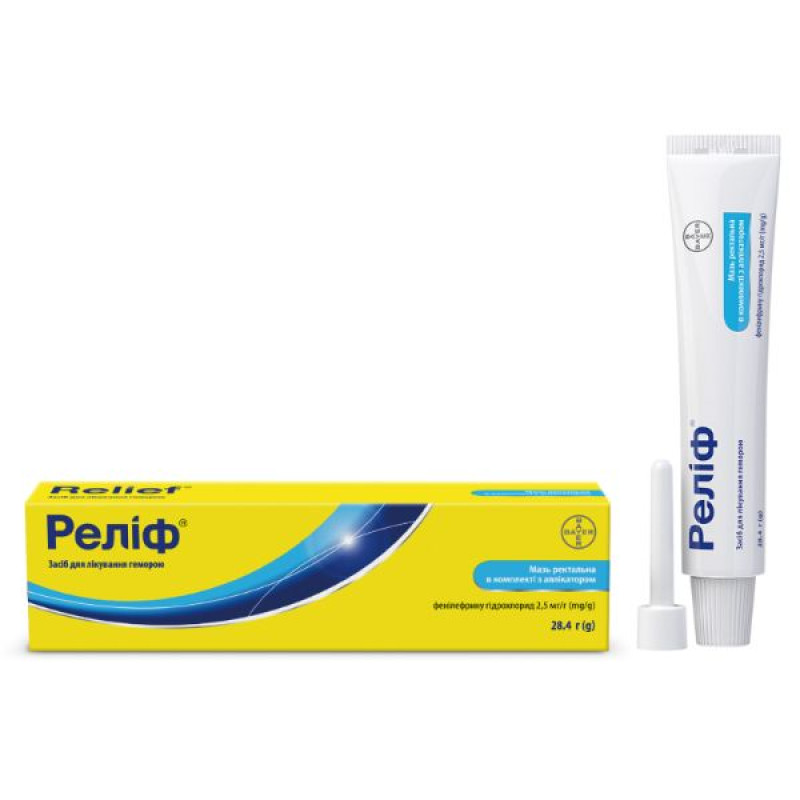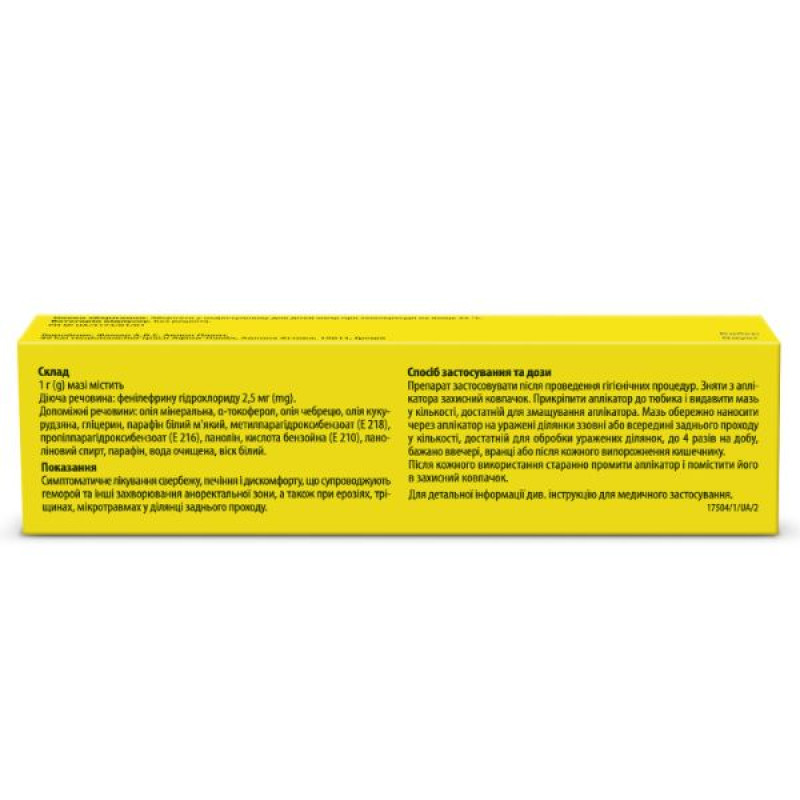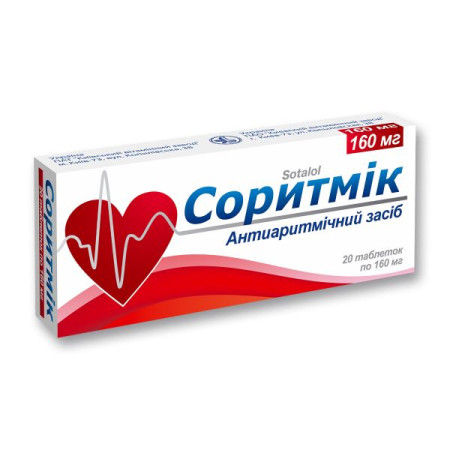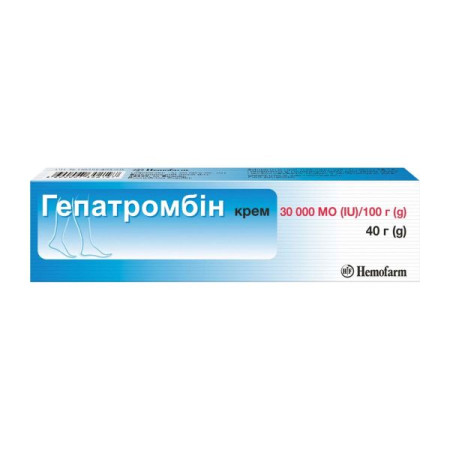Relief ointment rectal tube with applicator 28.4 g
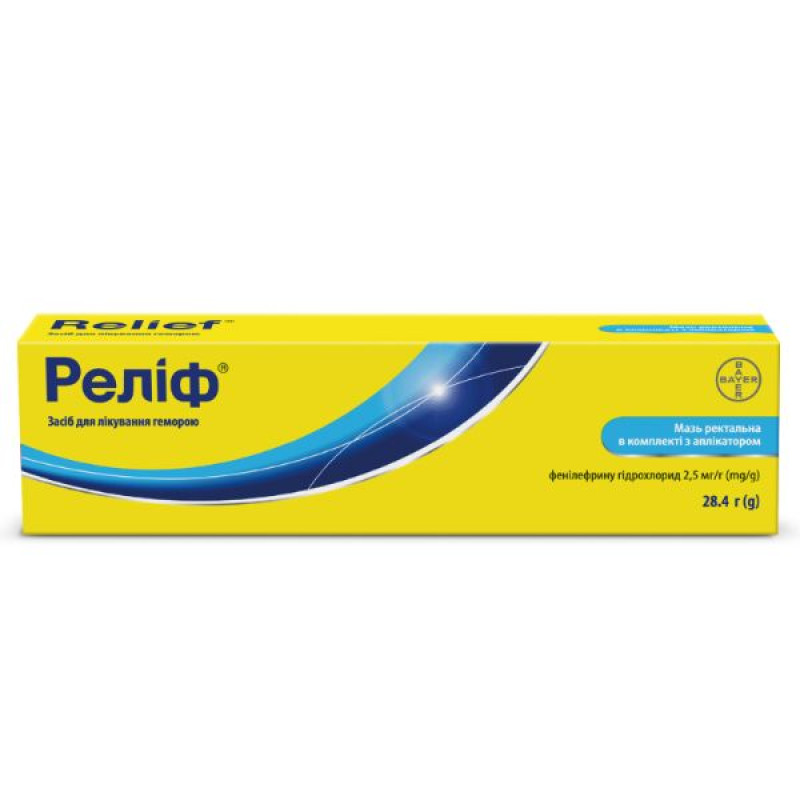
Instructions Relief ointment rectal tube with applicator 28.4 g
Composition
active ingredient: phenylephrine hydrochloride;
1 g of ointment contains phenylephrine hydrochloride 2.5 mg;
excipients: mineral oil, a-tocopherol, thyme oil, corn oil, glycerin, white soft paraffin, methyl parahydroxybenzoate (E 218), propyl parahydroxybenzoate (E 216), lanolin, benzoic acid (E 210), lanolin alcohol, paraffin, purified water, white wax.
Dosage form
Rectal ointment.
Main physicochemical properties: yellowish ointment without foreign particles.
Pharmacotherapeutic group
Topical remedies for treating hemorrhoids and anal fissures.
ATX code C05A X.
Pharmacological properties
Pharmacodynamics
Phenylephrine hydrochloride exhibits a local vasoconstrictor effect. This normalizes the ratio between blood flow to and blood flow from hemorrhoids, and also helps reduce exudation, swelling, itching, and serous discharge in hemorrhoids and other diseases of the anorectal area.
Pharmacokinetics
A drug for topical use. Phenylephrine, which is part of it, is inactivated by tissue monoamine oxidase, inactive metabolites are excreted in mucus or in small quantities by the kidneys.
Indication
Symptomatic treatment of itching, burning, and discomfort associated with hemorrhoids and other diseases of the anorectal area, as well as erosions, cracks, and microtraumas in the anus.
Contraindication
Increased individual sensitivity to any component of the drug, significant increase in blood pressure, tachysystolic heart rhythm disturbances, decompensated heart failure, cardiac conduction disorders, severe renal and hepatic failure, thyrotoxicosis, acute pancreatitis, simultaneous use with monoamine oxidase inhibitors (MAO) or within 15 days after discontinuation of treatment with MAO inhibitors, thromboembolic disease, granulocytopenia.
Interaction with other medicinal products and other types of interactions
It should not be used together with other vasoconstrictors (by any route of administration), as well as with antihypertensive drugs (ß-blockers), since phenylephrine may cause severe hypertension in some individuals due to stimulation of α-adrenergic receptors.
Atropine sulfate blocks the reflex bradycardia caused by phenylephrine and increases the vasopressor response to phenylephrine. Simultaneous administration of phenylephrine with ß-blockers can lead to arterial hypertension and excessive bradycardia with possible heart block. It should be used with caution with thyroid hormones, drugs that affect cardiac conduction (cardiac glycosides, antiarrhythmic drugs).
When used simultaneously with drugs that cause potassium excretion, for example, some diuretics such as furosemide, hypokalemia may be increased and arterial sensitivity to vasopressor drugs such as phenylephrine may be reduced.
Concomitant use of phenylephrine and other sympathomimetics may lead to additional stimulation of the central nervous system to an extremely high level, accompanied by nervousness, irritability, insomnia. Convulsions are also possible.
When using MAO inhibitors, consult a doctor before starting phenylephrine in the anorectal area. MAO inhibitors used before starting treatment with phenylephrine potentiate the cardiac and pressor effects of the latter, since the metabolism of phenylephrine is reduced.
When using Relief®, a rectal ointment, topically in the anus, the excipient white soft paraffin may reduce the strength and safety of latex condoms used concurrently with the drug.
Application features
In case of significant bloody discharge from the anus or if symptoms of the disease occur within 7 days of treatment or if the condition worsens, additional consultation with a proctologist is necessary.
This drug should be used with caution in patients with arterial hypertension, cardiovascular or cerebrovascular diseases, increased thyroid function (phenylephrine may cause adverse cardiovascular effects, especially when used in high doses or in sensitive individuals); angle-closure glaucoma.
Diabetic patients should use this medicine with caution: phenylephrine may increase blood glucose levels. These effects are usually temporary and minor and may increase if the recommended doses are exceeded. Blood glucose levels should be monitored more closely.
Individuals with urinary incontinence due to prostatic hypertrophy or neoplasm: Phenylephrine may impair urination in patients with prostatic hypertrophy due to spasm of the smooth muscles of the bladder neck, which occurs with stimulation of α1-adrenoreceptors.
It is necessary to consider the possibility of interaction of phenylephrine, which is applied topically in the anorectal area, if an appropriate level of systemic absorption is achieved, with MAO inhibitors, leading to potentiation of the hypertensive effect.
The possibility that phenylephrine, applied topically to the anorectal area, may cause severe hypertension due to α-adrenergic receptor stimulation in some individuals should be considered when this agent is used concomitantly with antihypertensive drugs.
In order to minimize systemic effects, the recommended dose should not be exceeded unless otherwise recommended by a doctor.
Use during pregnancy or breastfeeding
Since the safety of using Relief® (phenylephrine) during pregnancy has not been studied, the drug may be used if, in the opinion of the doctor, the benefit to the mother outweighs the potential risk to the fetus/child.
Pregnant women should consult a doctor before using the drug.
Since it is not known whether topical application of the drug Relief® (phenylephrine) would result in sufficient systemic absorption to cause measurable excretion in breast milk, the physician should determine the importance of the drug to the mother: whether it is necessary to discontinue breastfeeding or discontinue the drug.
Studies on the effect of the drug on fertility have not been conducted.
Ability to influence reaction speed when driving vehicles or other mechanisms
No effect on the ability to drive or use machines was observed.
Method of administration and doses
Adults and children over 12 years of age should use the drug after performing hygiene procedures. Remove the protective cap from the applicator. Attach the applicator to the tube and squeeze out the ointment in an amount sufficient to lubricate the applicator. Carefully apply the ointment through the applicator to the affected areas outside or inside the anus in an amount sufficient to treat the affected areas, up to 4 times a day, preferably in the evening, morning or after each bowel movement. Use until the symptoms of the disease disappear. After each use, thoroughly rinse the applicator and place it in the protective cap. Do not use if the protective coating is missing or damaged.
Children
The efficacy and safety of the drug Relief® in children under 12 years of age have not been studied. Data are not available.
Overdose
In medical practice, overdose has not been described; there are no data on systemic, including toxic, reactions of the body in response to rectal administration of the drug Relief®. However, in case of overdose, the manifestations of adverse reactions may be increased, especially with prolonged use. There may be arterial hypertension, pain and discomfort in the heart area, palpitations, shortness of breath, non-cardiogenic pulmonary edema, agitation, convulsions, sleep disorders, anxiety, paranoia, irritability, psychosis with hallucinations, weakness, anorexia, nausea, vomiting, oliguria, urinary retention, facial flushing, feeling of coldness in the extremities, paresthesias, hypersensitivity, hyperglycemia, hypokalemia, reduced blood flow to vital organs, which can lead to deterioration of blood supply to the kidneys, metabolic acidosis, increased load on the heart due to increased total peripheral vascular resistance. Treatment is symptomatic.
Adverse reactions
This medicine is usually well tolerated, but in rare cases adverse reactions due to phenylephrine hydrochloride are possible.
From the cardiovascular system: reflex bradycardia, arrhythmia, possible heart rhythm disturbances, increased blood pressure.
On the part of the immune system: allergic reactions, including cross-reactions with allergies to other sympathomimetics, which may manifest as rashes, itching, angioedema.
On the part of the endocrine system: increased symptoms of hyperthyroidism.
Skin and subcutaneous tissue disorders: contact dermatitis.
From the nervous system: dizziness, nervousness, headache, tremor, insomnia, feeling of fear, feeling of blood rushing to the face.
At the site of application, irritation, redness, rash, itching, swelling, moderate pain/burning in case of damage or bleeding from the anus may occur.
Methyl parahydroxybenzoate and propyl parahydroxybenzoate may cause allergic reactions (possibly delayed) and in isolated cases bronchospasm. Lanolin may cause local skin reactions (e.g. contact dermatitis). Benzoic acid is moderately irritating to the skin, eyes and mucous membranes.
Expiration date
2 years.
Opening the tube and starting to use the drug does not affect the shelf life, provided that the cap is tightly closed each time after use. Do not use after the expiration date indicated on the package.
Storage conditions
Store out of the reach of children at a temperature not exceeding 25 ºС.
Packaging
Primary: sealed laminated tube with plastic cap.
Secondary: cardboard box. Comes with a rectal applicator and instructions for medical use.
Vacation category
Without a prescription.
Producer
Famar A.V.E. Avlon Plant/Famar AVE Avlon Plant.
Location of the manufacturer and address of its place of business.
49th km National Road Athens-Lamia, Avlona Attiki, 19011, Greece.
There are no reviews for this product.
There are no reviews for this product, be the first to leave your review.
No questions about this product, be the first and ask your question.




